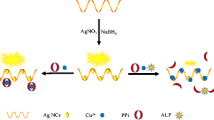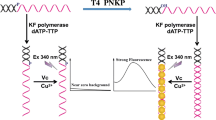Abstract
The authors describe a turn-off fluorometric method for the determination of the activity of the T4 polynucleotide kinase (T4 PNK). It is based on the use of DNA-templated silver nanoclusters (AgNCs). DNA probes with terminal 5′ hydroxy groups are used as substrates for DNA phosphatases. If subsequently treated with T4 PNK and Lambda exonuclease (λ exo), the AgNC DNA probes with a modified C-rich sequence and the G-rich sequence is separated. Upon their separation, the strong fluorescence (with excitation/emission maxima at 580/650 nm) that is caused by the proximity of the G-rich region and the C-rich region in the AgNCs decreases sharply. This enabled the fluorometric kinetic determination of the activity of T4 PNK. The assay is characterized by a wide linear range (from 0.01 to 12.5 U·mL−1), a low detection limit (0.01 U·mL−1) and short assay time (typically 60 min). This makes it a promising tool for use in studying processes related to DNA phosphorylation, in drug discovery and in diagnostics.

A turn-off fluorometric method for the determination of the activity of the T4 polynucleotide kinase (T4 PNK) has been developed. It is based on the use of DNA-templated silver nanoclusters (AgNCs). This makes it a promising tool for use in studying processes related to DNA phosphorylation, in drug discovery and in diagnostics.






Similar content being viewed by others
References
Foster ER, Downs JA (2010) Histone H2A phosphorylation in DNA double-strand break repair. FEBS J 272(13):3231–3240
Karimi-Busheri F, Daly G, Robins P, Canas B, Pappin DJC, Sgouros J, Miller GG, Fakhrai H, Davis EM, Le Beau MM, Weinfeld M (1999) Molecular characterization of a human DNA kinase. J Biol Chem 274(34):24187–24194
Zhao H, Liu Q, Liu M, Jin Y, Li B (2017) Label-free fluorescent assay of T4 polynucleotide kinase phosphatase activity based on G-quadruplexe−thioflavin T complex. Talanta 165:653–658
Li X, Xu X, Song J, Xue Q, Li C, Jiang W (2017) Sensitive detection of T4 polynucleotide kinase activity based on multifunctional magnetic probes and polymerization nicking reactions mediated hyperbranched rolling circle amplification. Biosens Bioelectron 91:631–636
Lin L, Liu Y, Yan J, Wang X, Li J (2013) Sensitive nanochannel biosensor for T4 polynucleotide kinase activity and inhibition detection. Anal Chem 85(1):334–340
Lin L, Liu Y, Zhao X, Li J (2011) Sensitive and rapid screening of T4 polynucleotide kinase activity and inhibition based on coupled exonuclease reaction and graphene oxide platform. Anal Chem 83(22):8396–8402
Sharma S, Doherty KM, Jr BR (2006) Mechanisms of RecQ helicases in pathways of DNA metabolism and maintenance of genomic stability. Biochem J 398(3):319–337
Wang LK, Shuman S (2001) Domain structure and mutational analysis of T4 polynucleotide kinase. J Biol Chem 276(29):26868–26874
Bernstein NK, Williams RS, Rakovszky ML, Cui D, Green R, Karimibusheri F, Mani RS, Galicia S, Koch CA, Cass CE (2005) The molecular architecture of the mammalian DNA repair enzyme, polynucleotide kinase. Mol Cell 17(5):657–670
Hou T, Wang X, Liu X, Lu T, Liu S, Li F, Chem A (2014) Amplified detection of T4 polynucleotide kinase activity by the coupled λ exonuclease cleavage reaction and catalytic assembly of bimolecular beacons. Anal Chem 86(1):884–890
Liu H, Ma C, Wang J, Chen H, Wang K (2017) Label-free colorimetric assay for T4 polynucleotide kinase/phosphatase activity and its inhibitors based on G-quadruplex/hemin DNAzyme. Anal Biochem 517:18–21
Chen W, Tu X, Guo X (2009) Fluorescent gold nanoparticles-based fluorescence sensor for Cu2+ ions. Chem Commun 13(13):1736–1738
Kim TI, Park J, Kim Y (2011) A gold nanoparticle-based fluorescence turn-on probe for highly sensitive detection of polyamines. Chem Eur J 17(43):11978–11982
Tan D, He Y, Xing X, Zhao Y, Tang H, Pang D (2013) Aptamer functionalized gold nanoparticles based fluorescent probe for the detection of mercury (II) ion in aqueous solution. Talanta 113(6):26–30
Liu H, Ma C, Wang J, Wang K, Wu K (2017) A turn-on fluorescent method for determination of the activity of alkaline phosphatase based on dsDNA-templated copper nanoparticles and exonuclease based amplification. Microchim Acta 184(1):1–6
Yeh HC, Sharma J, Iem S, Vu DM, Martinez JS, Werner JH (2012) A fluorescence light-up ag nanocluster probe that discriminates single-nucleotide variants by emission color. J Am Chem Soc 134(28):11550–11558
Yeh H-C, Sharma J, Han JJ, Martinez JS, Werner JH (2010) A DNA−silver nanocluster probe that fluoresces upon hybridization. Nano Lett 10(8):3106–3110
Latorre A, Somoza Á (2012) DNA-mediated silver nanoclusters: synthesis, properties and applications. Chembiochem 13(7):951–958
Han B, Wang E (2012) DNA-templated fluorescent silver nanoclusters. Anal Bioanal Chem 402(1):129–138
Liu W, Lai H, Huang R, Zhao C, Wang Y, Weng X, Zhou X (2015) DNA methyltransferase activity detection based on fluorescent silver nanocluster hairpin-shaped DNA probe with 5'-C-rich/G-rich-3′ tails. Biosens Bioelectron 68:736–740
Yan X, Sun J, Zhao X-E, Wang R, Wang X, Zuo Y-N, Liu W, Kong R, Zhu S (2018) Molecular beacon-templated silver nanoclusters as a fluorescent probe for determination of bleomycin via DNA scission. Microchim Acta 185(9):403. https://doi.org/10.1007/s00604-018-2939-7
Fan D, Zhu J, Liu Y, Wang E, Dong S (2016) Label-free and enzyme-free platform for the construction of advanced DNA logic devices based on the assembly of graphene oxide and DNA-templated AgNCs. Nanoscale 8(6):3834–3840
Shah P, Cho SK, Thulstrup PW, Bhang YJ, Ahn JC, Choi SW, Rørvig-Lund A, Yang SW (2014) Effect of salts, solvents and buffer on miRNA detection using DNA silver nanocluster (DNA/AgNCs) probes. Nanotechnology 25(4):111–120
Park KS, Park HG (2015) A DNA-templated silver nanocluster probe for label-free, turn-on fluorescence-based screening of homo-adenine binding molecules. Biosens Bioelectron 64:618–624
Zhu Z-M, Yu R-Q, Chu X (2014) Amplified fluorescence detection of T4 polynucleotide kinase activity and inhibition via a coupled lambda exonuclease reaction and exonuclease III-aided trigger DNA recycling. Anal Methods 6(15):6009–6014. https://doi.org/10.1039/c4ay01097c
Cheng R, Tao M, Shi Z, Zhang X, Jin Y, Li B (2015) Label-free and sensitive detection of T4 polynucleotide kinase activity via coupling DNA strand displacement reaction with enzymatic-aided amplification. Biosens Bioelectron 73:138–145
Zhang Y, Liu C, Sun S, Tang Y, Li Z (2015) Phosphorylation-induced hybridization chain reaction on beads: an ultrasensitive flow cytometric assay for the detection of T4 polynucleotide kinase activity. Chem Commun 51(27):5832–5835. https://doi.org/10.1039/c5cc00572h
Hou T, Wang X, Liu X, Pan C, Li F (2014) Sensitive electrochemical assay for T4 polynucleotide kinase activity based on dual-signaling amplification coupled with exonuclease reaction. Sensors Actuators B Chem 202(10):588–593
Huang Y, Chen J, Shi M, Zhao S, Chen ZF, Liang H (2013) A gold nanoparticle-enhanced fluorescence polarization biosensor for amplified detection of T4 polynucleotide kinase activity and inhibition. J Mater Chem B 1(15):2018–2021
Cen Y, Yang Y, Yu RQ, Chen TT, Chu X (2016) A cobalt oxyhydroxide nanoflake-based nanoprobe for the sensitive fluorescence detection of T4 polynucleotide kinase activity and inhibition. Nanoscale 8(15):8202–8209
Jiang H, Xu Y, Dai L, Liu X, Kong D (2018) Ultrasensitive, label-free detection of T4 ligase and T4 polynucleotide kinase based on target-triggered hyper-branched rolling circle amplification. Sensors Actuators B Chem 260:70–77
Zhou L, Cheng H, Wang Jin E, Pei R-J (2016) G-Quadruplex DNAzyme biosensor for quantitative detection of T4 polynucleotide kinase activity by using Split-to-intact G-Quadruplex DNAzyme conversion. Chin J Anal Chem 44(1):13–17. https://doi.org/10.1016/s1872-2040(16)60900-3
Song C, Yang X, Wang K, Wang Q, Liu J, Huang J, He L, Liu P, Qing Z, Liu W (2015) A sensitive detection of T4 polynucleotide kinase activity based on beta-cyclodextrin polymer enhanced fluorescence combined with an exonuclease reaction. Chem Commun 51(10):1815–1818. https://doi.org/10.1039/c4cc08991j
L-j W, Zhang Q, Tang B, C-y Z (2017) Single-molecule detection of polynucleotide kinase based on phosphorylation-directed recovery of fluorescence quenched by au nanoparticles. Anal Chem 89(13):7255–7261. https://doi.org/10.1021/acs.analchem.7b01783
Lin L, Shi D, Li Q, Wang G, Zhang X (2016) Detection of T4 polynucleotide kinase based on a MnO2 nanosheet-3,3′,5,5′-tetramethylbenzidine (TMB) colorimetric system. Anal Methods 8(20):4119–4126
Acknowledgments
This work is supported by the National Natural Science Foundation of China (Grant No. 81703088).
Author information
Authors and Affiliations
Corresponding authors
Ethics declarations
The author(s) declare that they have no competing interests.
Additional information
Publisher’s Note
Springer Nature remains neutral with regard to jurisdictional claims in published maps and institutional affiliations.
Electronic supplementary material
ESM 1
(DOCX 156 kb)
Rights and permissions
About this article
Cite this article
Li, J., Ma, J., Zhang, Y. et al. A fluorometric method for determination of the activity of T4 polynucleotide kinase by using a DNA-templated silver nanocluster probe. Microchim Acta 186, 48 (2019). https://doi.org/10.1007/s00604-018-3157-z
Received:
Accepted:
Published:
DOI: https://doi.org/10.1007/s00604-018-3157-z




